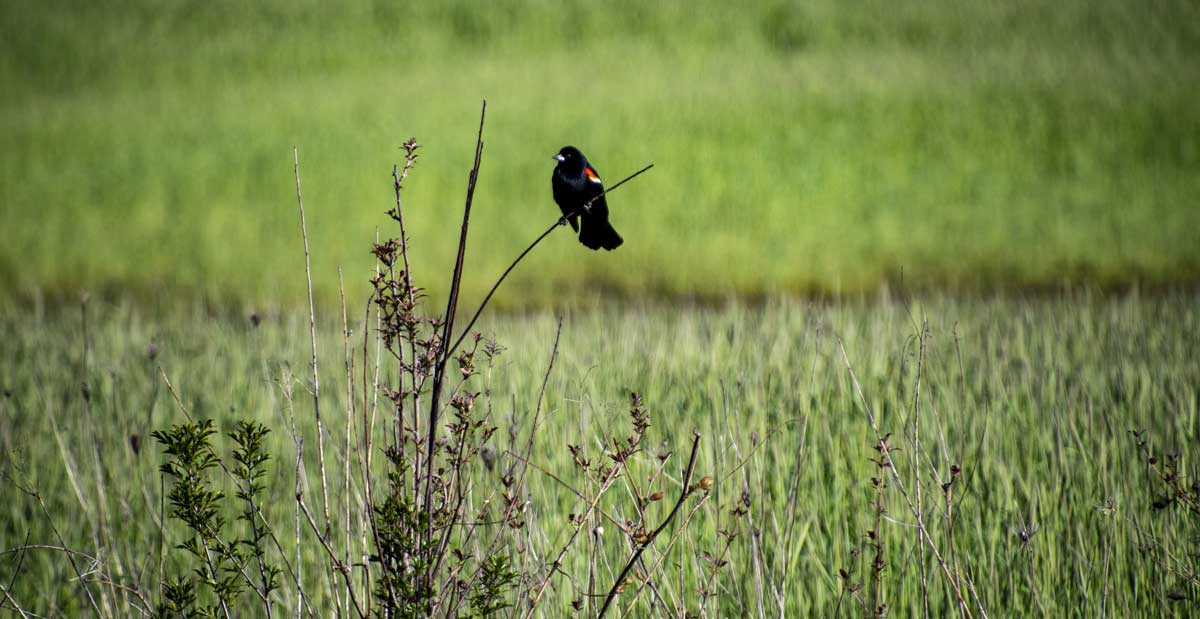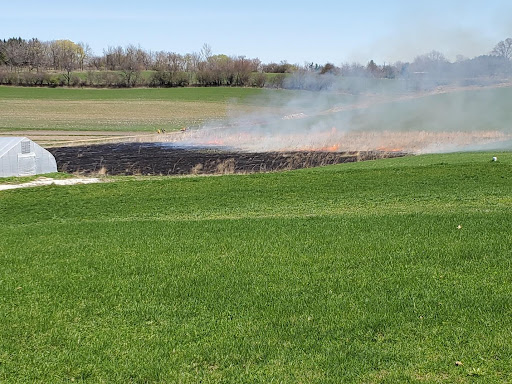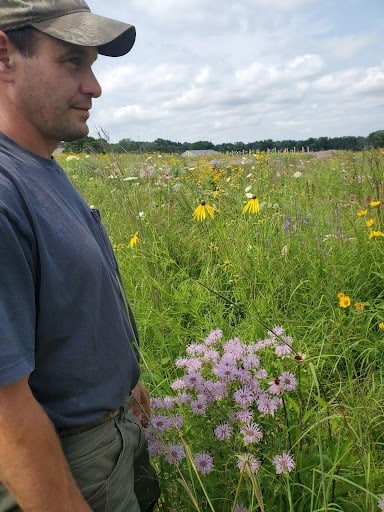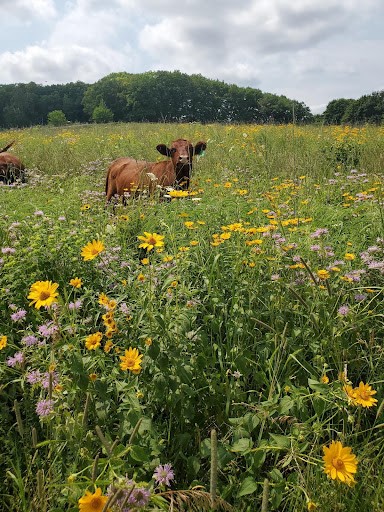
August 13, 2021
In 2019, Ryan Heinen, Gwenyn Hill’s Land and Livestock Manager, seeded ten acres of native grasses and forbs, replacing a relatively poor stand of alfalfa hay. Most of the field lies along Bryn Drive and is very visible from the road. For two years it looked rough and ratty. Common weeds were everywhere. More than once we were asked when we were going to mow down “that hillside.” Ryan held tough, assuring us all was going as planned. We’d see a succession of plants each year, with more of the prairie species dominating over time.

In its third spring Ryan lit the prairie on fire. In less than an hour the flames died leaving a stark black plot, wisps of smoke rising here and there. I snapped a few photos to record the day but the sun glinted in my lens. I intended to come back when the light was more favorable. Three busy days passed. By the time I returned the prairie was already greening up.
In the course of my typical farm day, I drive by the prairie planting at least once. I began regularly snapping photos of its ever-changing face. By mid-July the hillside was awash in colors and textures. Blooming forbs, swaying grasses and very few unsightly weeds, created a feast for the eyes.
I could recognize many of the common prairie species, but I wanted to know more. A few hours before Ryan turned the beef herd out to graze the prairie, I convinced him to give me a guided tour. Many grasses were chest high. While Indiangrass, big bluestem and little bluestem were prevalent, Ryan introduced me to side oats gramma, wild rye, western wheatgrass, and slender wheatgrass. Because it is still a young prairie, the flowering species we found the most of are considered pioneer species. They predominate in the early years while preparing the soil before the other species take hold and become more prevalent. Among the pioneer species of ox-eye daisy, gray-headed coneflower and black-eyed Susan’s we came upon small but healthy butterfly milkweed, Missouri milkvetch and purple prairie clover. Two of my favorite flowers, bergamot and purple coneflower, were in peak bloom.

I thought it a shame to let the Red Devons trample and graze this beautifully diverse hillside but that was not my farmer-brain thinking. What I have learned in my years working with Ryan is that protecting nature involves integrating it into the whole ecological system, not isolating it in an attempt to preserve it. Fire and grazing are necessary natural processes that keep the prairie diverse, healthy and working as a functioning ecological system. We are growing native species not solely for their beauty but for their contribution to the whole farm as pollinator and beneficial insect habitat, as partners in the support of a healthy soil microbiome, for nesting, feeding and sheltering wildlife, and as forage for hungry cattle in the heat of the summer.
We are growing native species not solely for their beauty but for their contribution to the whole farm as pollinator and beneficial insect habitat, as partners in the support of a healthy soil microbiome
The cattle pastures on our farm, as on most farms, consist of 4 – 8 non-native species of grasses and legumes. They grow best in cool seasons and go dormant in the warm season. Many native prairie species, with their 10 to 15 foot deep root systems, are adapted to cool season and warm season growth, providing a much needed source of food for grazing animals when the non-native pastures need to rest and recover. This is especially true this summer with its long rainless stretches.
Our tour over, Ryan completed the temporary fence and coaxed the cattle across Bryn Drive into the prairie. I wondered what they would do with such a new smorgasbord to dine on. Well, cows do what they do, they grazed. Without hesitation, regardless of the newness of some fifty different grasses, forbs and blossoms, they grazed. They looked so right moving slowly and purposefully across the prairie. In the heat of the day they sheltered under the mature oaks. As the sun slanted they returned to eat.

One week later the prairie was empty. Ryan had moved the beeves back across the road to a fresh pasture. It was no longer a majestic riot of color. The grasses were trampled and bent. Only the ox-eye daisy and grey-headed coneflower, an obvious least-favorite, towered like lonely sentinels over the nipped and clipped greenery. Though a sorry sight for the eyes, the grazing will leave much benefit in its wake. The addition of cow manure and urine along with the trampling and clipping will inoculate the soil with essential organisms many prairie plants need to germinate and grow.
While our ten acre prairie has not produced as many tons of forage as ten acres of our grassy pasture, it will, over time, have the staying power to play an important role in warm season pasture rotation. And, while our grassy pastures provide habitat for ground nesting birds and wildlife, the incredible diversity of well-managed native acres have been shown to sequester more carbon over time than non-native perennials, as well as providing much appreciated beauty along the way.
Read more about prairies and grazing prairies here: https://prairieecologist.com/
Linda Halley has managed Gwenyn Hill Organic Farm and Gardens since 2017.
